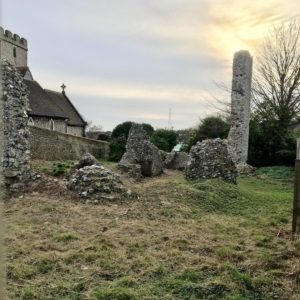Brighthelmstone: Brighton in the Middle Ages
This is a legacy story from an earlier version of our website. It may contain some formatting issues and broken links.
Amidst the modern buildings of today’s Brighton are an abundance of medieval churches, streets and manors which may go unnoticed to many residents.
The term ‘medieval’ refers to the Middle Ages, a period of European history which is broken into three subdivisions: Early Middle Ages (5th century – 10th century), High Middle Ages (10th century – 13th century) and Late Middle Ages (13th century – 15th century).
One of the earliest mentions of Brighton was in the Domesday Book of 1086 commissioned by William the Conqueror, in which the town was referred to as Brighthelmstone.
In 1313, King Edward II granted a charter to hold annual fairs in Brighthelmstone as well as a three-day fair in celebration of the Feast of St Bartholomew in August. Charters were first used in the Early Middle Ages as an early form of documentation and record keeping which allowed a town a certain amount of rights. Once granted a charter, the town was considered founded. This allowed the town to flourish and daily fish markets were held on the beach, although these markets were not made official until the 1773 Brighton Town Act was passed. This followed a charter granted for John de Warenne, 7th Earl of Surrey in 1312 to hold an annual fair in Portslade in celebration of the Feast of St Nicholas on 6th December.
Built in the 13th century, St Bartholomew’s Grange was one of Brighthelmstone’s earliest buildings. It was founded by St Pancras Priory, Lewes, and stood on St Bartholomew’s Square where Brighton Town Halll now stands. The grange was burned down during a French attack on Brighton in June 1514 along with almost every other building in the town.
The oldest remaining building in Brighton is St Nicholas Church on Dyke Road. Its history dates back to at least the 11th century with its first mention in the Domesday Book, with reference to a church valued at £12. However, only some of these features can still be seen; most of the current building is 14th century. Although there is no physical evidence remaining today, there was a record of a church in the same place in the early 10th century. The Norman font is the oldest surviving relic of the church, dating to c1170.
In fact, churches are arguably the most valuable insight into medieval life in Brighton as there are many churches dotted around the city which date back to the Middle Ages.
As for All Saints Church, the Domesday Book suggests that a church existed in Patcham at the time but it was rebuilt in the 12th and 13th century with some features still remaining today, including a blocked-off doorway in the north aisle which is still viewable from both inside and outside the church. Above the chancel arch is a 13th century Doom Painting, a type of wall painting found in medieval churches depicting the Last Judgement.
Dating back to the 13th century, St Peter’s Church in Preston Village boasts a truly impressive history. The current building replaced a previous church which was mentioned in the Domesday Book. In 1830 a series of 13th and 14th century frescoes (a type of mural) were discovered under a layer of plaster which had been covered during the Reformation. They depict the Nativity, the murder of Thomas Becket (Archbishop of Canterbury from 1162-1170) and St Michael weighing souls.
The 11th century Hangleton Manor was owned by William de Warenne, 1st Earl of Surrey. Although this part of the building is not visible today, the Old Manor House, built in the late 15th century, is. The nearby St Helen’s church has a similar Norman history, also dating back to the 11th century and St Helen’s Green, adjacent to the church, was used as a plague pit for victims of the Black Death in the 14th century.
St Wulfran’s Church in Ovingdean originates from the 12th century with 13th century additions, including a tower and aisle, although little remains of these original medieval features.
One of the most fascinating treasures of Brighton’s early history is Portslade Old Manor, a 12th century manor house of which the ruins still survive. Even more fascinating is the life of one of its owners, Hubert de Burgh. His political career began as Earl of Kent and was later appointed Chief Justiciar in 1215 under King John and continued into the reign of John’s son and successor, Henry III. At the time, the role of Chief Justiciar was possibly the highest ranking position in the country except for the king. The ruins are next to the 12th century St Nicholas Church. Read the February 2006 issue of the Pavilion Review for more information on the manor.
In Brighton Museum’s Elaine Evans Archaeology Gallery is a display focused on Anglo-Saxon Brighton. It features skeletons excavated in Brighton and a facial reconstruction of the individual known as Stafford Road Man. The gallery also features a digital reconstruction made by Grant Cox of ArtasMedia of a village in the Saxon era, which gives an insight into how Brighton may have looked in the Early Middle Ages.
Tasha Brown, Museum Futures Trainee






